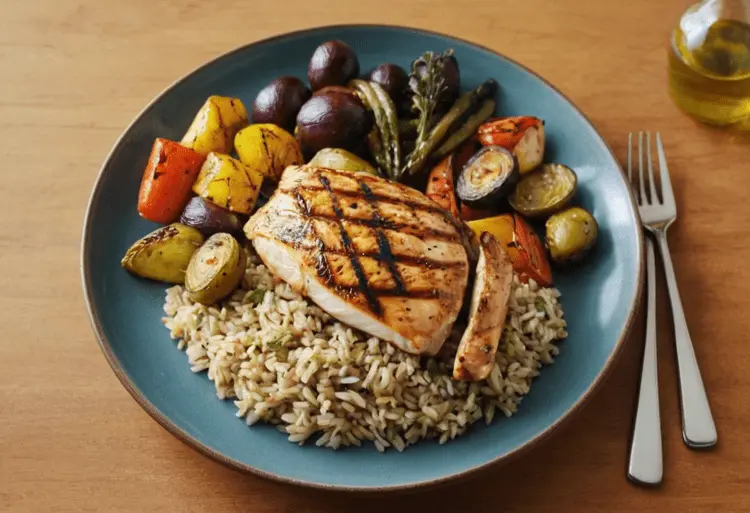Macro Diet: Your Key to a Flexible and Sustainable Eating Lifestyle
Tired of restrictive diets that leave you feeling deprived and discouraged? Ever wish you could enjoy your favorite foods while still achieving your health and fitness goals? The macro diet might be your answer.
Unlike fad diets that come and go, the macro diet focuses on understanding and balancing your macronutrients – the building blocks of your nutrition: protein, carbs, and fats.
By tailoring your intake to your unique needs and goals, you can create a sustainable, enjoyable eating plan that supports your well-being.
No more counting calories or banning entire food groups. With flexible dieting, you’ll discover a whole new world of macro-friendly recipes and learn the art of macro tracking to achieve the perfect macronutrient balance. Ready to unlock a healthier, happier you?
Macro Diet in a Nutshell
- Not a restrictive diet
- Focus on macronutrients
- Personalized nutrition
- Flexible meal planning
- Sustainable lifestyle change
Table of contents
Introduction to the Macro Diet

Embark on a Journey to Nutritional Freedom with the Macro Diet
Have you ever felt trapped by the restrictive nature of traditional diets? Are you tired of counting every calorie and feeling guilty about enjoying your favorite foods? If so, the macro diet might be the refreshing change you need.
But what is the macro diet, exactly? It’s not just another fad diet, but a sustainable lifestyle change that focuses on macronutrients – the essential building blocks of our food: protein, carbohydrates, and fats.
Instead of obsessing over calorie counts, you’ll learn to balance these macros to achieve your health and fitness goals.
Unlock Your Potential with the Macro Diet
- Sustainable Weight Management: Unlike crash diets, the macro diet promotes steady and maintainable progress, leading to long-term success.
- Improved Body Composition: By tailoring your macro ratios, you can sculpt your body to your liking, whether it’s building lean muscle or losing body fat.
- Enhanced Energy and Performance: Fuel your body with the right balance of macros to feel energized throughout the day and perform at your peak in workouts and sports.
Curious about how much protein, carbs, and fat you should be consuming? Head over to this handy Macro Calculator to determine your personalized macro targets.
Who Can Benefit from the Macro Diet?
- Fitness Enthusiasts: Optimize your diet to maximize your athletic performance and achieve your fitness goals.
- Health-Conscious Individuals: Gain a deeper understanding of your nutritional needs and make informed food choices.
- Anyone Seeking a Flexible Approach: The macro diet offers the flexibility to enjoy a variety of foods while still maintaining a healthy lifestyle.
Why This Guide Stands Out
We’re not just scratching the surface here. This guide will delve deep into the science behind the macro diet, provide practical tips for beginners and experienced macro counters alike, and empower you to make the macro diet work for you.
Now that you’ve unlocked the power of the macro diet, are you ready to take your nutrition tracking to the next level?
Understanding Macronutrients
Alright, folks, let’s dive into the nitty-gritty of the macro diet – the macronutrients themselves. Think of them as the Lego blocks that build your body, fuel your workouts, and keep you feeling awesome.
But what exactly are these power players, and why are they so essential for a successful macro diet? Let’s break it down.
Protein: Your Muscle’s Best Friend
Ever wonder how your body repairs and builds muscle? Protein is the answer. It’s like the construction crew of your body, essential for growth and repair.
- What it does: Builds and repairs tissue, produces enzymes and hormones, and can be used as energy when carbs and fats are scarce.
- Where to find it: Meat, poultry, fish, eggs, dairy, legumes, tofu, nuts, and seeds.
- Recommended intake: A general guideline is 0.8 grams of protein per kilogram of body weight. However, those on a macro diet, especially athletes or those aiming to build muscle, often aim for a higher intake.
Carbohydrates: Your Body’s Preferred Energy Source
Carbs often get a bad rap, but they’re not the enemy! In fact, they’re your body’s go-to energy source, fueling your brain and muscles for daily activities. But not all carbs are created equal.
- What they do: Provide energy for your body and brain, support digestion, and contribute to overall health.
- Where to find them: Whole grains, fruits, vegetables, legumes, dairy, and starchy vegetables.
- Recommended intake: Typically, 45-65% of your daily calories should come from carbohydrates, but this can vary depending on your goals and activity level.
Fats: Not the Foe You Think They Are
Fats have long been demonized, but they’re vital for your health! They provide energy, support cell growth, protect your organs, and help your body absorb essential vitamins.
- What they do: Provide long-lasting energy, support cell growth, protect organs, help absorb vitamins, and keep you feeling full.
- Where to find them: Avocados, nuts, seeds, olive oil, fatty fish, eggs, and full-fat dairy.
- Recommended intake: Aim for 20-35% of your daily calories from healthy fats.
Remember: The key to a successful macro diet is finding the right balance of macronutrients for YOUR body and goals. It’s about nourishing yourself with whole, nutrient-dense foods, not deprivation.
So, what are your favorite sources of protein, carbs, and healthy fats? Share your go-to macro-friendly meals in the comments below or tag us on social media! We’d love to see what you’re cooking up.
How to Get Started with the Macro Diet

Ready to dive into the world of macronutrients and take control of your nutrition? Great! Let’s break down the steps to get you started on your macro diet journey.
1. Calculate Your Calorie Needs
The first step is figuring out how many calories your body needs to maintain its current weight. This is called your Total Daily Energy Expenditure (TDEE), and it depends on your basal metabolic rate (BMR), activity level, and weight goals.
So, what’s your BMR? It’s the number of calories your body burns at rest, just to keep your vital functions going. Your activity level takes into account how much you move throughout the day.
And finally, your weight goals tell us if you want to maintain, lose, or gain weight.
Don’t worry, you don’t need to do complex calculations yourself. An online macro calculator can do the heavy lifting for you. Simply enter your details, and it’ll give you an accurate estimate of your calorie needs.
2. Set Your Macro Ratios
Now for the exciting part – setting your macro ratios! This is where the macro diet truly shines. There’s no one-size-fits-all approach. You can customize your ratios based on your goals, preferences, and lifestyle.
Want to build muscle? You might need more protein. Looking for sustained energy? Complex carbs are your friends. Aiming for optimal health? Don’t forget those healthy fats!
A common starting point is the 40/30/30 ratio: 40% carbohydrates, 30% protein, and 30% fat. But remember, this is just a guideline. You can experiment and find what works best for you.
3. Track Your Macros
Time to become a macro detective! This means tracking your macronutrient intake throughout the day. You can use a food diary, a mobile app, or even a simple spreadsheet.
To get the most accurate data, weigh and measure your food. This might seem a bit tedious at first, but it gets easier with practice. Plus, it’s incredibly empowering to know exactly what you’re putting into your body.
Don’t forget to factor in the macronutrient content of your food. For example, a 100-gram serving of chicken breast contains about 30 grams of protein, 0 grams of carbohydrates, and 3.6 grams of fat.
4. Adjust and Fine-Tune
The macro diet is not about perfection; it’s about progress. Keep track of your results and make adjustments as needed. If you’re not seeing the desired changes, don’t be afraid to tweak your macro ratios or calorie intake.
Remember, everyone is unique. What works for one person may not work for another. Listen to your body, experiment, and find your perfect macro balance.
Tips for Success on the Macro Diet

Thriving with Macros: Your Macro Diet Playbook
Navigating the macro diet can feel like a culinary adventure, but with the right strategies, you’ll be a macro master in no time. Curious about how to make this lifestyle change stick? Let’s dive into the secrets of macro diet success.
Embrace Whole, Unprocessed Foods
Ever wonder what fuels your body best? Fresh, whole foods like colorful vegetables, lean proteins, and healthy fats are the cornerstones of the macro diet. Why? They’re packed with nutrients that keep you energized and satisfied.
Ever notice how a meal of processed snacks leaves you feeling sluggish? That’s your body craving real, wholesome nourishment.
Plan and Prep Your Macro Meals
Do you struggle with making healthy choices on the fly? By planning and prepping your meals in advance, you’ll have nutritious options ready when hunger strikes. This not only saves you time but also helps you stay on track with your macro goals.
Don’t Fear Healthy Fats
Are you still wary of fats? It’s time to rewrite the narrative. Healthy fats like avocados, nuts, and olive oil are essential for hormone balance, brain health, and feeling satiated. These fats aren’t your enemies; they’re your allies in achieving a balanced macro diet.
Hydration is Key
Do you know how much water your body truly needs? Proper hydration is crucial for digestion, energy levels, and overall well-being. It’s easy to mistake thirst for hunger, so make sure you’re sipping on water throughout the day.
Listen to Your Body’s Signals
Do you tune into your body’s unique cues? Your body is constantly communicating with you. Pay attention to hunger, fullness, and cravings. These signals can help you adjust your macro intake and ensure you’re nourishing your body effectively.
Celebrate Small Wins and Stay Consistent
Are you ready to embrace the macro diet journey? Remember, progress takes time. Celebrate small victories, like mastering a new recipe or hitting your macro goals for the week. Consistency is key, so keep going even if you have an off day.
Mastered macros and ready for the next level? Discover the 90-30-50 Diet Plan: a targeted approach to weight loss that builds on your newfound macro knowledge for even greater results!
Addressing Common Concerns and FAQs
Let’s tackle some burning questions about the macro diet, shall we?
Use a macro calculator! There are many free ones available online that take into account your age, gender, weight, activity level, and goals to determine your personalized macronutrient needs.
A common starting point is a ratio of 40% protein, 30% carbs, and 30% fat. However, this can be adjusted based on individual preferences and needs.
This is a macro ratio of 50% carbs, 30% protein, and 20% fat. It’s a good option for active individuals or those seeking a higher carb intake.
Nope! Unlike fleeting diet trends, the macro diet is a sustainable approach rooted in balancing your body’s core building blocks – protein, carbs, and fat. It’s about understanding your body’s needs, not restricting them.
Not necessarily! While tracking is crucial for getting started, it becomes intuitive over time. Many people find they naturally choose foods that align with their macro goals after a while.
Of course! With a little planning, eating out is totally doable. Check online menus for nutritional information, or ask your server for modifications. Remember, it’s all about balance and fitting those delicious meals into your daily macros.
The macro diet can absolutely be adapted to fit your needs! Whether you’re vegetarian, vegan, gluten-free, or have other dietary concerns, you can still reap the benefits of counting macros.